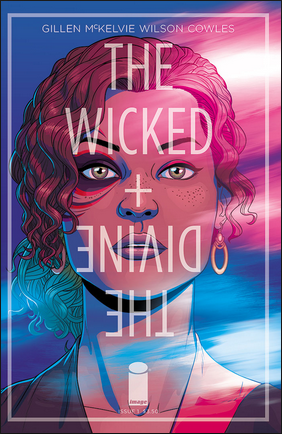Why I (almost) never post on the blog:
I am self-assured in that whatever I have to say on any subject at any time is not going to be worth reading by anyone anywhere. So I haven’t written anything. But now I remember that nobody reads this thing anyway, which could be deemed as a better reason to keep myself from posting; however, my serious self-doubt is trumped by my desire to somehow produce something that somewhere, someone might actually appreciate. So here it goes, my review of The Wicked and the Divine by creative team: Gillen, McKelvie, Wilson, and Cowels.
After reading Kieron Gillen’s and Jamie McKelvie’s Young Avengers I was thrilled to see the pitch for The Wicked and The Divine in whichever issue of the Previews catalog it appeared. I read the book last night and was captivated instantly.
The Wicked and The Divine briefly transports the reader into the past, specifically New Year’s Eve 1923, before jumping forward into the present year (exactly 90 years and one day) where Laura brings us with her to see Amaterasu perform in a seemingly magical concert packed with concupiscent teens trying to get a piece (of divinity). In this world the gods of myth are real and appear, briefly but resplendently, as larger-than-life pop stars once a century in what is referred to as “The Recurrence.”
Gillen’s witty and perceptive writing relates the story without condescension. Much of the backstory is communicated through a media interview with Amaterasu, which is a highly likely scenario considering that she has only existed in this form for a few weeks at this point in the timeline, and that we currently live in a culture consumed with getting the inside story. More than just exposition takes place here too, as it should considering the number of pages devoted to playing out this scene. Gillen and McKelvie reveal the subtle dynamics of relationship between the gods in a few succinct interactions. They show the scorn felt for these deities as well as hint at their intentions while physically manifested. These details could not be conveyed so concisely without the collaboration of words and images by the creative team. McKelvie has a crisp and effortless style that is only augmented by Matthew Wilson’s vibrant and impeccable colouring choices. Clayton Cowels’ lettering is all but invisible as spoken dialogue and inconspicuous as internal monologue, which is entirely the point.
While I’m a little confused about who the main character, Laura, is and what makes her special enough to be singled out by Luci (Lucifer), I realize that isn’t the main drive of the first issue. The most important thing that we need to know about her is that she wants in- she wants it all. The rest we’ll get to discover later. The predominant questions I have relate to the circle of icons that forward the division of each god era. Where are the rest of the gods represented on the symbol wheel? Why were there fewer totems and more skulls in the 1920’s recurrence than the present day and is that significant? Am I over analyzing? No, of course not.
Plot doesn't take a back seat to explanation and character introduction either. In a surprising development, issue one ends with a murder trial and possible frame job. But how does one prove or disprove a god's guilt? And furthermore, can you actually implement judgement in either case? The layers of thinkyness here are myriad both diegetically and philosophically.
The Wicked and The Divine is an exploration into the cultural obsession with self-gratification, fame, and lavish overabundance. I definitely have questions that need answers and I’m excited to be on the journey to find them. Come with me?


